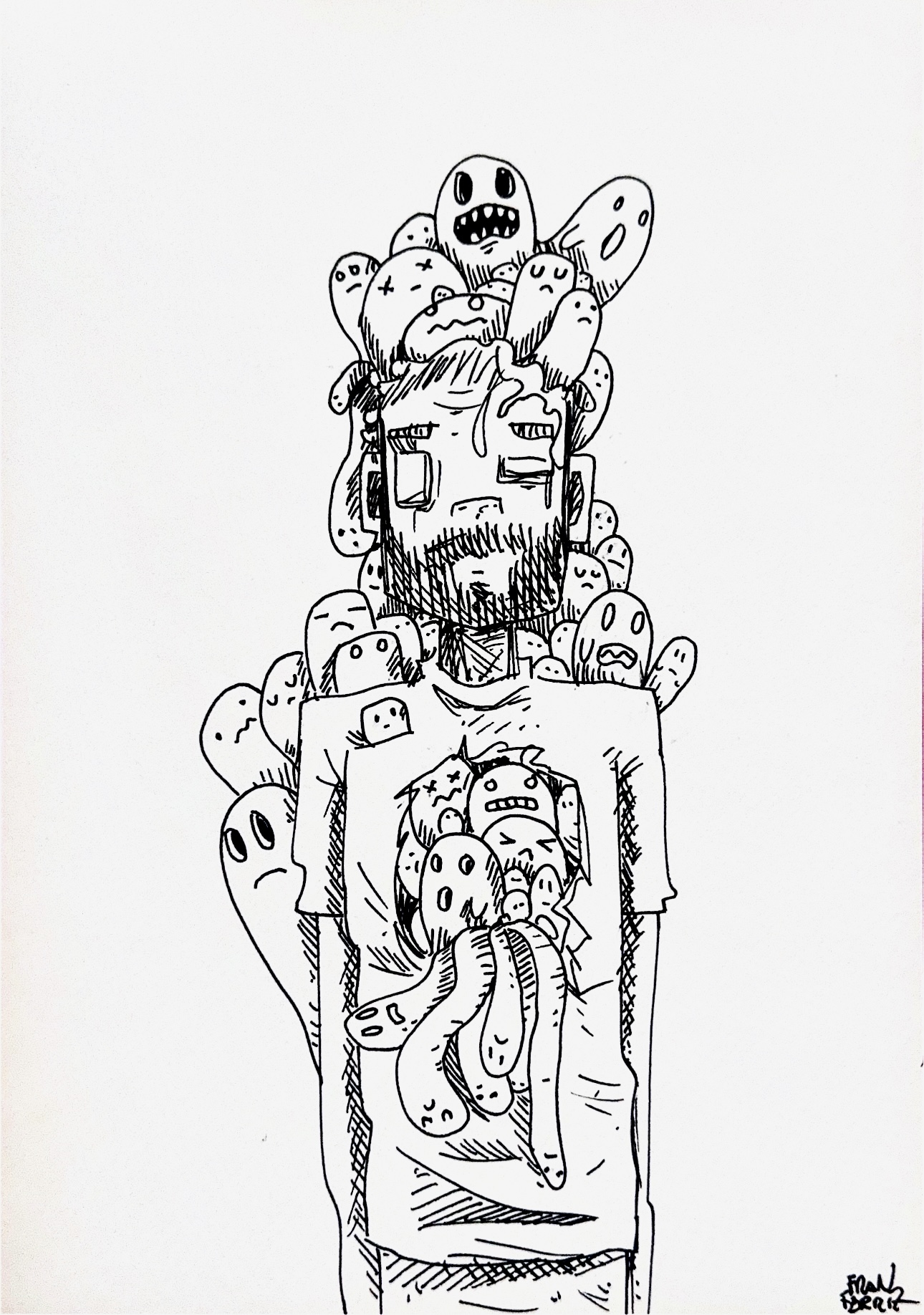Obra de Fran Ferriz donada por el artista. Colección Kripties Fundación.
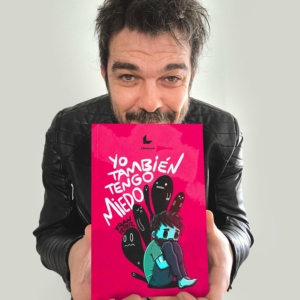 Fran, has transitado un camino muy interesante hasta llegar a la ilustración y la novela gráfica. ¿Podrías compartir con nosotros qué te motivó inicialmente a explorar el arte gráfico y cómo ha evolucionado tu carrera hasta ahora?
Fran, has transitado un camino muy interesante hasta llegar a la ilustración y la novela gráfica. ¿Podrías compartir con nosotros qué te motivó inicialmente a explorar el arte gráfico y cómo ha evolucionado tu carrera hasta ahora?
El dibujo me ha gustado desde que tengo memoria y siempre supe que quería vivir de ello, dedicar mi vida al arte. Por suerte hasta el día de hoy me he podido dedicar a ello. He trabajado como diseñador gráfico e industrial, diseñador de juguetes, ilustrador editorial, artista conceptual para cine y como escritor. Y sigo disfrutando de ello.
Tu última obra es tanto personal como universal en sus temas. ¿Qué te inspiró a abordar la salud mental de una manera tan abierta y única en Yo también tengo miedo?
Es un tema que me ha interesado desde hace muchos años, siempre he expresado mis sentimientos a través del dibujo y ahora quería escribir una novela sobre ello. Supongo que el hecho de haber sido diagnosticado con diversos trastornos de salud mental, ha hecho que el tema cada vez me interese más.
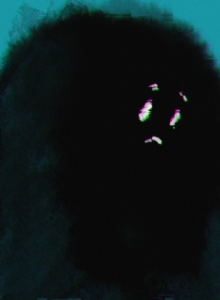 Crear una novela gráfica que aborde temas tan delicados como los trastornos mentales debe de ser un gran desafío. ¿Cómo fue el proceso creativo para esta obra y qué desafíos enfrentaste al ilustrar temas tan complejos?
Crear una novela gráfica que aborde temas tan delicados como los trastornos mentales debe de ser un gran desafío. ¿Cómo fue el proceso creativo para esta obra y qué desafíos enfrentaste al ilustrar temas tan complejos?
Quizá lo más difícil fue mirar dentro de mí. No es una autobiografía, pero el protagonista comparte muchas cosas conmigo y aunque es una novela de ficción, hay mucho de verdad en ella. Escribiendo “Yo también tengo miedo” he reído, he sufrido, he llorado y he disfrutado. He tratado abordar el tema desde mi experiencia personal. No soy psicólogo, ni el libro pretende ser un manual de autoayuda, simplemente cuento la historia de alguien con ciertos trastornos y como acaba aceptándose y conociéndose.
¿Qué impacto esperas que tenga tu libro en los lectores y qué tipo de retroalimentación has recibido hasta ahora de aquellos que han interactuado con la obra?
Simplemente espero que la gente disfrute la lectura y se quede con un buen sabor de boca al acabar la novela. Me he enfrentado a ello desde el dolor, pero también desde el humor y creo que cualquier persona puede sentirse identificada de una manera u otra con los personajes del libro. Hasta ahora los comentarios y reseñas están siendo muy positivos.
En Kripties Fundación creemos firmemente en el poder del arte para fomentar el cambio social y la inclusión. Desde tu perspectiva, ¿cómo puede el arte, y específicamente la novela gráfica, contribuir a la mejora de la sociedad, especialmente en los jóvenes?
Siempre digo que el arte es lo que nos hace humanos y nos diferencia de otros seres vivos. El arte está para provocar en el sentido más amplio del verbo. En el caso de mis ilustraciones sobre salud mental, lo que creo haber logrado es que mucha gente se sienta reflejada en ellas y por tanto, sientan que no están solas.
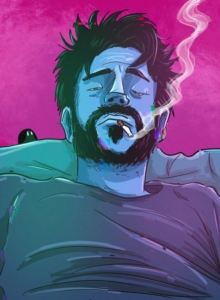 En muchas ocasiones, los artistas encuentran en sus propias experiencias una fuente de inspiración. ¿Hay elementos de tu vida personal reflejados en la historia de Dante?
En muchas ocasiones, los artistas encuentran en sus propias experiencias una fuente de inspiración. ¿Hay elementos de tu vida personal reflejados en la historia de Dante?
Sí, sin duda hay mucho de mí en Dante, aunque toda la historia es ficción. El personaje comparte conmigo los mismos trastornos y muchas experiencias, aunque luego la historia sea inventada.
¿Cómo crees que la narrativa visual puede ayudar a desestigmatizar y promover una mayor comprensión de la salud mental?
De momento ya se ha conseguido que la salud mental esté en boca de todo el mundo y eso ya es un gran logro. En mi caso, comencé a ilustrar sobre ello hace más de una década, no me he unido a la “moda”, y creo que el simple hecho de hablar de ello y mostrarlo, ya es un paso de gigante. Algo tan sencillo como reconocer que no estamos bien y hablarlo, es importantísimo.
Después de Yo también tengo miedo, ¿tienes planeado seguir explorando temas similares en futuros trabajos o te interesa aventurarte en nuevos géneros o temas?
Creo que desde que comencé con mis dos primeras novelas de la saga “Cosas Terribles”, de la que ahora estoy terminando la tercera entrega, he mostrado interés por estos temas y aunque cambie de géneros en el futuro, creo que siempre habrá algo de ello en mis personajes.
¿Le darías algún consejo a los artistas emergentes que quieren usar su arte para hablar de temas complejos?
Les diría que sean valientes, que los artistas que emergen ahora son los que van a contar las historias de los próximos años. Ser artista, sobre todo en España, no es precisamente fácil, pero sin duda es una profesión que te devuelve todo lo que das, sobre todo en cuanto al cariño de la gente y los fans.
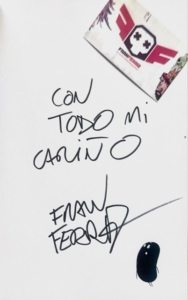
¿Te han propuesto alguna exposición monográfica? ¿Te animarías a hacerla con nosotros?
Precisamente ahora estoy exponiendo en mi ciudad, Villena, en el marco del Estigma Festival, un festival precisamente sobre salud mental. Anteriormente expuse en Benidorm junto a otros ilustradores una serie de ilustraciones sobre el confinamiento y la pandemia, que fue muy bien recibida.
Por supuesto, me animaría a exponer con vosotros 🙂
No dudes de que pronto te tomaremos la palabra.
 Fran, you have had a very interesting journey into illustration and graphic novels, could you tell us what first motivated you to explore graphic art and how your career has developed so far?
Fran, you have had a very interesting journey into illustration and graphic novels, could you tell us what first motivated you to explore graphic art and how your career has developed so far?
I have loved drawing for as long as I can remember and I have always known that I wanted to make a living from it, to dedicate my life to art. Luckily I have been able to do that to this day. I have worked as a graphic and industrial designer, a toy designer, an editorial illustrator, a film conceptual artist and a writer. And I still enjoy it.
Your latest work is both personal and universal in its themes. What inspired you to tackle mental health in such an open and unique way in Yo también tengo miedo?
It is a subject that has interested me for many years, I have always expressed my feelings through drawing and now I wanted to write a novel about it. I suppose the fact that I have been diagnosed with various mental disorders has made the subject more and more interesting to me.
 Creating a graphic novel that deals with such sensitive issues as mental illness must be a great challenge. What was the creative process for this work and what challenges did you face in illustrating such complex issues?
Creating a graphic novel that deals with such sensitive issues as mental illness must be a great challenge. What was the creative process for this work and what challenges did you face in illustrating such complex issues?
Perhaps the hardest part was looking inside myself. It is not an autobiography, but the protagonist shares many things with me, and although it is a fictional novel, there is a lot of truth in it. While writing «I’m afraid too» I laughed, I suffered, I cried and I enjoyed it. I tried to approach the subject from my own personal experience. I am not a psychologist and the book does not pretend to be a self-help manual, I simply tell the story of someone with certain disorders and how they eventually come to accept and know themselves.
What impact do you hope your book will have on readers and what kind of feedback have you received so far from those who have interacted with the work?
I just hope that people enjoy reading it and are left with a good taste in their mouths when they finish the novel. I approached it with pain, but also with humour, and I think everyone can relate to the characters in the book in one way or another. So far the comments and reviews have been very positive.
At the Kripties Foundation, we strongly believe in the power of art to promote social change and inclusion. From your perspective, how can art, and graphic novels in particular, contribute to the betterment of society, especially for young people?
I always say that art is what makes us human and distinguishes us from other creatures. Art is there to provoke in the broadest sense of the word. In the case of my mental health illustrations, I think I have achieved that many people feel reflected in them and therefore feel that they are not alone.
 Artists often find inspiration in their own experiences. Are there elements of your personal life reflected in Dante’s story?
Artists often find inspiration in their own experiences. Are there elements of your personal life reflected in Dante’s story?
Yes, there is certainly a lot of me in Dante, although the whole story is fiction. The character shares with me the same disorders and many experiences, although the story is made up.
How do you think visual storytelling can help to de-stigmatise and promote a better understanding of mental health?
For now, mental health is on everyone’s lips, and that’s a huge achievement. In my case, I started illustrating about it more than a decade ago, I have not joined the ‘fashion’ and I think the simple fact of talking about it and showing it is already a huge step. Something as simple as recognising that we are not well and talking about it is very important.
After Yo también tengo miedo, do you plan to continue exploring similar themes in future works or are you interested in venturing into new genres or topics?
I think that ever since I started the first two novels in the Terrible Things saga, of which I am now finishing the third, I have been interested in these themes, and even if I change genres in the future, I think there will always be something of this in my characters.
Do you have any advice for emerging artists who want to use their art to talk about complex issues?
I would tell them to be brave, because the artists who are coming up now are the ones who will be telling the stories of the next few years. It is not easy to be an artist, especially in Spain, but without a doubt it is a profession that gives you back everything you give, especially in terms of the affection of people and fans.
Have you been proposed a monographic exhibition and would you like to do it with us?
I am currently exhibiting in my town, Villena, as part of the Estigma Festival, a festival about mental health. I previously exhibited in Benidorm with other illustrators, a series of illustrations about imprisonment and the pandemic, which was very well received.
Of course I would love to exhibit with you 🙂
We are sure that we will soon be taking you at your word.

